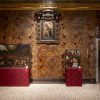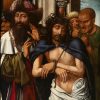The room beyond this served as an archive, and was presumably lined with shelves and cabinets, similar to that one can now see on the far wall. This was not part of the original furnishings, nor were the cuoridoro, the gold-embossed leather panelling one can see on the other walls.
WORKS ON DISPLAY:
Quentin Metsys (ca. 1465-1530)
Christ Mocked, ca. 1529
Oil on panel
The depicted episode takes up the passage from the Gospel of John in which Christ, after his capture, is presented to the crowd with the words “Ecce homo” or “Behold the Man!”. The painting captures the moment in which the body of Christ, already emaciated and suffering, is offered by his tormentors to the crowd. Behind him, a man with aggressive and violent features holds the rope that binds his hands. To the left of Jesus is Pontius Pilate, richly dressed: with the gesture of his hands he intends to communicate his non-involvement in the facts, but his gaze betrays the doubt of having condemned an innocent man. Documented in Venice already in the late sixteenth century, as evidenced by the numerous derivations, including a copy preserved today in Museo Correr and a mosaic by Antonio Zuccato dated 1587, this work was noticed in 1581 by Francesco Sansovino, who remembers it on the altar of the small church of Palazzo Ducale.
Hieronymus Bosch (follower of)
Apocalyptic Vision, third quarter of the 16th century
Oil on panel
The panel depicts an apocalyptic vision, generally identified as a depiction of hell. The theme was very dear to the followers and imitators of Hieronymus Bosch, a highly renowned Dutch painter active between the end of the fifteenth century and the beginning of the sixteenth century. The set of these curious and at times cruel scenes directly recall some of the models used by the Flemish master in his works. What stands out is the attention to detail, a typically Flemish feature that was appreciated by numerous Venetian collectors of the time, interested in creating universal encyclopedic collections.


